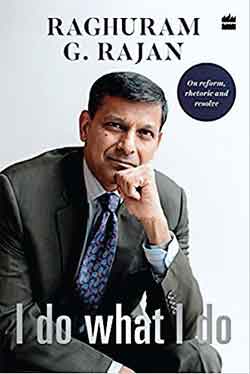Demonetisation and its Discontents Oct 17
I had planned to write on demonetisation for the November issue (as it will be the one-year anniversary of this landmark announcement), but my fellow professor and renowned economist Raghuram Rajan forced me into a corner when he released his book I do what I do, which drew public attention back to demonetisation. There is no doubt that demonetisation was an unprecedented economic policy decision, not just for India but for the entire world. While the possible benefits of pulling out high-value currency notes from circulation had certainly been discussed theoretically, India became the first country in the world to actually pull its own high-value tenders from the monetary system without external pressure or duress.
Rajan’s book puts the onus squarely on Prime Minister Modi. Reducing black money, it was believed, would decrease the gap between the rich and poor in India, increase the tax base, lower corruption, and dry up the funding for terrorist activities. For his critics, demonetisation was a brave, but foolhardy, exercise that earned Modi the not-so-honorable comparison with 13th century Muslim sultan Muhammad Bin Tughlaq. Modi’s Tughlaqi approach to demonetisation, critics observed, threw the whole country into chaos and disarray, with common folks fighting each other as they waited in endless lines to save their precious cash holdings from becoming worthless.
I argue that demonetisation was, in fact, the wrong weapon in India’s fight against black money. What most people do not seem to appreciate is that black money in India is NOT a richperson problem, but an everyman issue. Every Indian person—rich or poor, urban or rural, man or woman—has ‘black money’ assets either in cash or non-cash such as jewelry, which they cannot completely account for in the legal sense.
There are several reasons for this, but three are most important to understand. First, a large part of the Indian populace is selfemployed, with income mostly in cash, which means it never gets recorded in the formal economy. Consider that even in Delhi, no one really knows how many people are self-employed, running micro ventures or small businesses that do not exist legally (think, the vegetable vendor who makes the rounds in your neighbourhood or the college girl next door who teaches science or math to the little kids in the evening). There are also those who run legal businesses, and it is anyone’s guess how many of those there are in Delhi (leave alone the whole country).
Second, from the lowly clerk to the top bureaucrats in the country, corruption is pervasive, and all the money that gets exchanged under-the-table is part of the black economy. When the lowly traffic constable takes Rs 200 for jumping the red light, s/he is generating income that goes undeclared.
Third, most economic transactions in India are in cash, so there is no formal record of them having occurred. As long as Indian people pay for a haircut or for bhelpuri or a rickshaw ride without getting a legal receipt back, there is no stopping the creation of black money in the country.
Modi’s decision to demonetise ended up hurting the very people it was supposed to benefit primarily because it targeted black money, as if the average person in India had nothing to do with its generation or consumption.
When most Indians think black money, they are usually referring to the tons of unaccounted money accumulated by political leaders and parties. Unfortunately, the demonetisation decision did nothing to pursue this form of black money, and in fact, ended up encouraging it.
Consider just one prominent example: The Bahujan Samaj Party deposited at least Rs100 crore in its account immediately after demonetisation, which immediately legalised their otherwise-illegal hoard of cash. Not just the BSP, but every political party in India, from the north to the south, had tons of black money, most of which has now been legalised thanks to demonetisation.
So, where did demonetisation get us as a country? As Rajan noted, the RBI’s official position was that, in the short-term, demonetisation has more costs than benefits. Events since last November prove that Rajan is correct on the short-term pains of demonetisation. It is too early to have evidence for longterm effects of demonetisation, but I suspect that there will be little, if any, benefits for the average Indian in the long-run. Whether history will remember Modi as a modern-day Tughlaq for his decision to demonetise in the face of advice to the contrary from his economic team (including Rajan as RBI Governor) is another issue that will be resolved only with time in the long term.
Rajan’s book puts the onus squarely on Prime Minister Modi. Reducing black money, it was believed, would decrease the gap between the rich and poor in India, increase the tax base, lower corruption, and dry up the funding for terrorist activities. For his critics, demonetisation was a brave, but foolhardy, exercise that earned Modi the not-so-honorable comparison with 13th century Muslim sultan Muhammad Bin Tughlaq. Modi’s Tughlaqi approach to demonetisation, critics observed, threw the whole country into chaos and disarray, with common folks fighting each other as they waited in endless lines to save their precious cash holdings from becoming worthless.
I argue that demonetisation was, in fact, the wrong weapon in India’s fight against black money. What most people do not seem to appreciate is that black money in India is NOT a richperson problem, but an everyman issue. Every Indian person—rich or poor, urban or rural, man or woman—has ‘black money’ assets either in cash or non-cash such as jewelry, which they cannot completely account for in the legal sense.
There are several reasons for this, but three are most important to understand. First, a large part of the Indian populace is selfemployed, with income mostly in cash, which means it never gets recorded in the formal economy. Consider that even in Delhi, no one really knows how many people are self-employed, running micro ventures or small businesses that do not exist legally (think, the vegetable vendor who makes the rounds in your neighbourhood or the college girl next door who teaches science or math to the little kids in the evening). There are also those who run legal businesses, and it is anyone’s guess how many of those there are in Delhi (leave alone the whole country).
Second, from the lowly clerk to the top bureaucrats in the country, corruption is pervasive, and all the money that gets exchanged under-the-table is part of the black economy. When the lowly traffic constable takes Rs 200 for jumping the red light, s/he is generating income that goes undeclared.
Third, most economic transactions in India are in cash, so there is no formal record of them having occurred. As long as Indian people pay for a haircut or for bhelpuri or a rickshaw ride without getting a legal receipt back, there is no stopping the creation of black money in the country.
Modi’s decision to demonetise ended up hurting the very people it was supposed to benefit primarily because it targeted black money, as if the average person in India had nothing to do with its generation or consumption.
When most Indians think black money, they are usually referring to the tons of unaccounted money accumulated by political leaders and parties. Unfortunately, the demonetisation decision did nothing to pursue this form of black money, and in fact, ended up encouraging it.
Consider just one prominent example: The Bahujan Samaj Party deposited at least Rs100 crore in its account immediately after demonetisation, which immediately legalised their otherwise-illegal hoard of cash. Not just the BSP, but every political party in India, from the north to the south, had tons of black money, most of which has now been legalised thanks to demonetisation.
So, where did demonetisation get us as a country? As Rajan noted, the RBI’s official position was that, in the short-term, demonetisation has more costs than benefits. Events since last November prove that Rajan is correct on the short-term pains of demonetisation. It is too early to have evidence for longterm effects of demonetisation, but I suspect that there will be little, if any, benefits for the average Indian in the long-run. Whether history will remember Modi as a modern-day Tughlaq for his decision to demonetise in the face of advice to the contrary from his economic team (including Rajan as RBI Governor) is another issue that will be resolved only with time in the long term.





